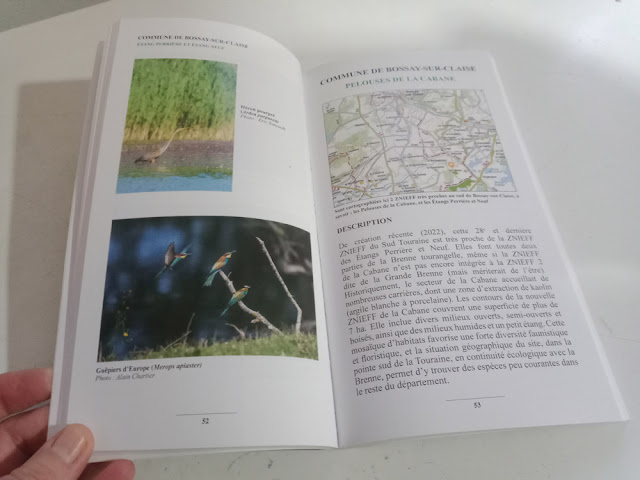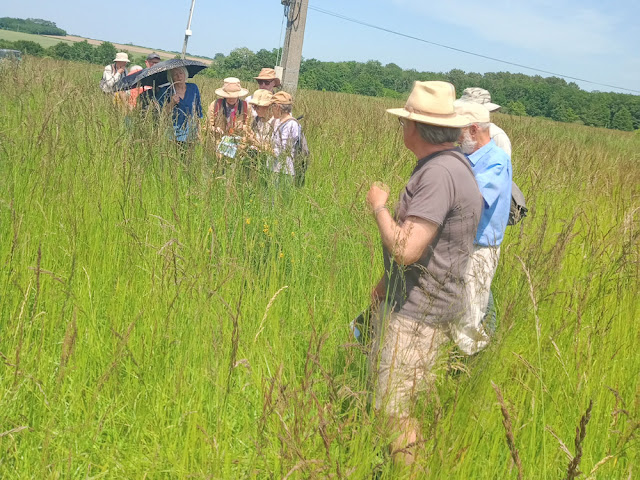The long awaited (well, by me at any rate) guide to the Zones Naturelles d'intéret écologique, faunistique et floristique du Sud Touraine is finally out. It is great!
The front cover of the guide.
The guide is the result of 5 years of work by a small team led by Francois Lefebvre, ably assisted by Jean-Claude Jacques. I contributed some photos and helped with the field work and biodiversity surveying. Over the life of the project Francois had 3 interns who got a glimpse of real working life as an ecologist as part of their university training. My friends Alain Chartier, Marc Fleury and Jean Pelle all contributed photos and provided lots of historical knowledge of the sites. Yohann Sionneau contributed his specialist knowledge of the River Claise and its tributaries. Olivier Lorain did the graphic design and printing. The book is dedicated to the memory of botanist extraordinaire Francois Botté, and there are a number of other ecologists, botanists, entomologists and naturalists involved who I never got to meet.
Open at the chapter for La Cabane.
The guide was produced because Francois Lefebvre recognised that we have something rather special in the Sud Touraine. Our chalky limestone means that water has carved out numerous valleys and natural cavities which have been subsequently modified by man. The climate is sub-Mediterranean, and we are on the northern limits of the distribution for many southern species. The proximity to the Brenne means that we also have inland wetland habitats and the species associated with them. In a relatively small area we have a remarkable diversity of species. Consequently there are today 28 sites identified and classified at national level as ZNIEFF, acknowledging their exceptional interest in terms of the flora and/or fauna present.
The back of the guide, which says: "The Sud Touraine, gâtine* country, with its great residual stands of forest, and its numerous valleys cut into the Turonian chalk still exhibits a number of preserved habitats. Wet heathland, chalk mounds, underground cavities, natural grasslands at the base of valleys...These are the places, often a bit hidden and difficult to access, that we want to introduce you to, across 28 sites classed as ZNIEFF, real reservoirs of local biodiversity."
*Gatine is land that has low nutrient, heavy, poorly draining clay soil. This heath and poor natural grassland surrounded by forest was traditionally used to pasture goats and sheep, until the 19th century when it began to be cultivated.
Here is the official blurb, from Jean-Claude, and translated by me:
The Patrimoine Vivant en Claise Tourangelle (PVCT) association has spent 5 years updating or creating the 28 reports describing the most remarkable natural environments in southern Touraine and listing some of the emblematic animal and plant species they shelter.
These reports, illustrated with location maps and numerous color photos, have just been published: Les ZNIEFF du Sud Touraine - Zones Naturelles d'intérêt Écologique, Faunistique et Floristique. Les Cahiers de la Claise n°13 (see cover photo).
This 159-page publication is on sale for €14 at the Grand-Pressigny Tourist Office and at the "Le Petit Fabien" bookshop in Preuilly-sur-Claise.
It can also be ordered from PVCT (7 Grande Rue, 37350 Le Grand Pressigny) with a cheque for 20€ (14€ + 6€ postage).
If you are interested in the nature of the Sud Touraine I highly recommend you get a copy of this guide. And keep an eye out for announcements from me on FB that there will be an outing to one or more of the sites next year.
An outing for the general public on behalf of Botamyco37 in May 2023 to La Cabane, Bossay sur Claise, one of the sites featured in the guide.
In order to have a site declared as a ZNIEFF the owner needs to be sympathetic to the idea of protecting nature. The aim is to raise awareness and offer a limited level of protection to the site. For example, should the owner decide to sell and a new owner wished to develop the site they would be unlikely to get planning permission.





No comments:
Post a Comment